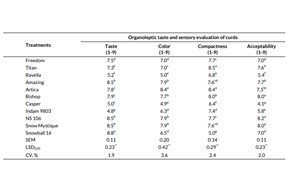Performance on postharvest quality of late season cauliflower (Brassica oleracea var. botrytis L.) varieties in Terai region of Nepal
Abstract
The experiment was conducted at Horticulture Farm of Agriculture and Forestry University, Rampur, Nepal during the November 2016 to March 2018 for two consecutive years to assess the characteristics on postharvest quality of late season cauliflower varieties. The experiment was laid in a Randomized Complete Block Design (RCBD) with the eleven late season cauliflower varieties viz., Freedom, Titan, Ravella, Amazing, Artica, Bishop, Casper, Indam 9803, NS 106, Snow Mystique, and Snowball 16, each replicated with four times. Significantly higher TSS value of 5.7º Brix was produced by Snowball 16 than other varieties. Considerably higher vitamin C of 49 mg/100 g was found in Amazing than other varieties. Significantly lower physiological loss in weight of 5.3%, 9.6% and 15.6% was found in Artica at three, six and nine days after harvesting, respectively. Higher score for the taste of curd was 8.8 in Snowball 16 followed by Amazing while lower score for taste of the curd was 4.8 in Indam 9803 variety. The attractive color and more compact curd score of 8.4 was found in both Titan and Artica than other varieties. Therefore, it can be concluded that Snowball 16 and Amazing varieties were the best open pollinated varieties for taste of the curd and composition of chemical constitutes. Bishop, Snow Mystique, NS 106, Artica and Titan varieties were other probable hybrid varieties based on their overall postharvest characteristics.
Keywords:
Cauliflower, Late season, Organoleptic taste, Post-harvest, QualityDownloads
References
Abbey, L., Joyce, D.C., Aked, J. and Smith, B. (2002). Genotype, sulfur nutrition and soil type effects on growth and dry-matter production of spring onion. The Journal of Horticultural Science and Biotechnology, 77(3): 340-345.
Ashraf, M.I., Sajad, S., Hussain, B., Sajjad, M., Saeed, M.S., Sattar, S. and Iqbal, M.A. (2017). Physiological attributes of cauliflower (Brassica oleracea var. botrytis L.) as influenced by the application of different levels of nitrogen and hand weeding.
Chatterjee, R. and Mahanta, S. (2013). Performance of off-season cauliflower (Brassica oleracea var. botrytis L.) under agro shade net as influenced by planting dates and nutrient source. Environment, 1 (1): 56-62.
Gomez, K.A. and Gomez, A.A. (1984). Statistical procedures for agricultural research. 2ndedn. International Rice Research Institute, College, Laguna, pp. 680.
HRD (2013). Annual report. Horticulture Research Division, Nepal Agricultural Research Council, Khumaltar, Lalitpur.
Keck, A.S. (2004). Cruciferous vegetables: cancer protective mechanisms of glucosinolate hydrolysis products and selenium. Integrative Cancer Therapies, 3: 5-12.
Kindo, S.S. (2018). Varietal Evaluation of Cauliflower [Brassica oleracea var. botrytis L.] Under Agro-climatic Condition of Allahabad. International Journal of Pure & Applied Bioscience, 6(1): 672–677.
Krishi Diary. (2019). Krishi Diary. Government of Nepal, Agriculture Information and Communication Centre
Kumar, M., Sharma, S.R., Kalia, P. and Saha, P. (2011). Genetic variability and character association for quantitative and quality traits in early maturing Indian cauliflowers. Indian Journal of Horticulture, 68(2): 206-211.
Kumar, V., Thakur, R.K. and Kumar, P. (2019). Assessment of heavy metals uptake by cauliflower (Brassica oleracea var. botrytis) grown in integrated industrial effluent irrigated soils: A prediction modeling study. Scientia Horticulturae, 257: 108682.
Labate, J.A., Robertson, L.D, Baldo, A.M. and Bjӧrkman, T. (2006). Inflorescence identity gene alleles are poor predictors of inflorescence type in broccoli and cauliflower. Journal of American Society of Horticulture Science, 13: 667-673.
Meena, M.L., Ram, R.B., Lata, R. and Sharma, S.R. (2010). Determining yield components in cabbage (Brassica oleracea var. capitata L.) through correlation and path analysis. International Journal of Science and Nature, 1(1): 27-30.
Pandey, Y.R. (2003). Evaluation of cauliflower varieties and their planting dates for commercial production under Jumla Agro-Ecological Condition. Agricultural research for enhancing livelihood of Nepalese people. In: Proc. 2nd SAS-N convention, 30 July-1 August, 2003, pp: 207-210.
Pandey, Y.R. and Pokhrel, T.R. (2000). Varietal evaluation of late season cauliflower. In Proceedings of the Third National Horticultural Research Workshop (pp. 46-49). Horticulture Research Division-NARC, Khumaltar.
Poudel, D.D., Horwath, W.R., Lanini, W.T., Temple, S.R. and Van Bruggen, A.H.C. (2002). Comparison of soil N availability and leaching potential, crop yields and weeds in organic, low-input and conventional farming systems in northern California. Agriculture, ecosystems & environment, 90(2): 125-137.
Pun, A.B., Pandey, Y.R. and Yadav, Y.P. (2003). Performance of cauliflower varieties under different agro-ecological domains of western hills of Nepal. Agricultural research for enhancing livelihood of Nepalese people. In: proc. 2nd SAS-N convention, 30 July-1 August 2003, pp: 235-238.
Sharma, S., Singh, Y. and Sharma, S. (2018). Studies on Mean Performance for Yield and its Contributing Traits in Cauliflower (Brassica oleracea var. botrytis L.) under mid hill conditions of northwestern Himalayas. International Journal of Current Microbiology and Applied Science, 7(2): 3288-3296.
Shrestha, J. (2019). P-value: A True Test of Significance in Agricultural Research, http://doi.org/10.5281/zenodo.4030711.
Singh, D.N. and Nath, V. (2011). Varieties and Hybrids of Vegetables. Satish Serial Publishing House, Delhi, pp. 426.
Singh, D.K. (2007). Modern Vegetable varieties and Production Technology. International Book Distributing Co, Lucknow, pp. 393.
Yadav, M., Prasad, V.M. and Ahirwar, C.S. (2013). Varietal evaluation of cauliflower (Brassica oleracea var. botrytis L.) in Allahabad agro-climatic condition. Trends in Biosciences, 6(1): 99-100.

Published
How to Cite
Issue
Section
Copyright (c) 2020 Agriculture and Environmental Science Academy

This work is licensed under a Creative Commons Attribution-NonCommercial 4.0 International License.

